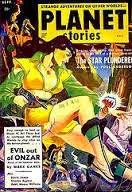Two stories by Poul Anderson about Dominic Flandry defending the Terran Empire were published in 1951. Two prequels were published in 1952:
"Sargasso of Lost Starships" (Jan '52) is set in the earlier Empire;
"The Star Plunderer" (Sept '52) is set just before the founding of the Empire.
Three of these four stories were published in Planet Stories. Thus, here already is a four part future history.
Because they were published so early and so close together, "...Plunderer" and "Sargasso..." share some distinctive features not common to the rest of what became the Technic History. Terminological differences do not matter since we must understand that the dialogue read by us in English was spoken in Anglic.
In "...Plunderer," Manuel Argos says that he will proclaim "...the Empire of Sol."
-Poul Anderson, Rise Of The Terran Empire (New York, 2011), p. 357.
He addresses his followers as "'...men of Sol.'" (p. 358)
In this space opera, men no longer identify themselves as citizens of a nation or even of Earth but of the Solar System. The former government of the System is referred to as the Commonwealth and we know from other installments of the History that its full name was the Solar Commonwealth.
"Sargasso..." refers to "...blue-uniformed Solarian [not Terran] marines..." (p. 370).
Basil Donovan refers to the "'...upstart Solar Empire...'" (p. 376) and "'...the almighty Empire of Sol...'" (p. 389) and Tetsuo Takahashi, an Imperial ship's exec says:
"'Old Manuel I had the guts to proclaim himself Emperor of Sol...'" (p. 384).
Manuel did that "'...two hundred years ago...'" (ibid.), when the Commonwealth had broken up.
Thus, these two stories are already a well-integrated future history. At some stage between Takahashi and Flandry, there is a shift of emphasis so that the Empire comes to be seen as centered not on the entire Solar System but more specifically on Terra.

6 comments:
Hi, Paul!
I can imagine people in the Early Empire using "Sol" and "Terra" interchangeably. With "Terra" eventually becoming the preferred form. The United States, for example, was at first called the "United Colonies" before switching to "States." So there are real history analogues for what you discussed.
Sean
Sean,
Agreed. Also, US citizens are called "Americans" when, in another sense, they are one kind of North American.
Interstellar empires are implausible cliches but PA makes his seem credible.
Paul.
Hi, Paul!
Quite true, the US comprises only part of the North American CONTINENT. Canada and Mexico are also parts of that continent.
I certainly agree that Poul Anderson makes both his Polesotechnic League and Terran Empire! But he used one thing, implausible now, but not totally, which makes such things credible. See below.
I don't think intierstellar empires, federations, confederations, etc., are necessarily implausible. I remember Jerry Pournelle, in his essay about how he and Larry Niven wrote THE MOTE IN GOD'S EYE, writing that an interstellar empire would be possible if you had a FTL drive. I think expansionist nations and empires tend to grow as large as the technology available to them will allow. Of course, I realize many other factors plays a role as well!
Sean
Sean,
When I read MOTE, I felt that the Empire of Man was simply a copy of such Empires as described by Asimov and Anderson but, when I had read some of the thinking behind it, it came to seem more substantial.
Paul.
Hi, Paul!
While I don't think Pournelle/Niven's Co Dominium/Empire of Man stories are QUITE as good as PA's Polesotechnic League/Terran Empire tales, they are still better than Asimov's own efforts. Maybe the CoDo/Empire stories simply needed to be fleshed out more fully with additional works.
Also, one important difference we see in THE MOTE IN GOD'S EYE from PA's works is that MOTE was a first contact novel, of mankind first making contact with non human intelligent beings. My impresssion was that the CoDo/Empire stories speculates that intelligent life might not be as numerous and widespread as we see in Anderson's woks.
And the available technology will also dictate how far empires or federations can expand. A STL space tecnology means states may expand to govern only individual solar systems. A FTL drive makes larger oganizations and polities more plausible.
Sean
"A STL space tecnology means states may expand to govern only individual solar systems."
I think I would quibble on that.
I would expect some sort of federation to cover Alpha Centauri A & B, which *might* also cover Proxima Centauri.
Vernor Vinge in "A Deepness in the Sky" & Joan Vinge in "Outcasts of the Heaven Belt" show some plausible (?) very loose interstellar organizations.
Karl Schroeder in "Permanence" shows the 'cycler compact' in which a loose agreement between the governments of solar systems keeps interstellar 'cyclers' travelling between stars.
He helps the plausibility by postulating that brown dwarfs are substantially more common than stars & bodies orbiting them can be colonized, so the nearest neighbor distances are relatively modest.
Here is his essay on how it might work.
https://www.kschroeder.com/my-books/permanence/the-cycler-compact/
Post a Comment